
Click here to read No-Prep Earth Science Experiment for Curious Kids on Hands On As We Grow®
Learn how the sun works with a simple earth science experiment for kids from Julie!
My kids are always asking for more experiments.
This simple earth science experiment helps children understand that different materials warm and cool at different speeds. And it’s easy to relate to everyday life!
Keep learning with 50 simple science experiments for kids at home.
No-Prep Earth Science Experiment for Curious Kids
For this earth science experiment, you’ll need:
- two identical cups
- freezer
- a meat thermometer
- dirt
- water
- sunshine

Preschoolers love this simple “what dissolves” experiment!
Setting the Stage with Dirt & Water
First, fill one cup with water and the other with dirt.
Talk about how the different materials react differently to the sun’s heat. Have your kids make predictions or guesses about what will most likely happen next.
Which will warm up the fastest?

Write down your child’s predictions and any reasoning behind their thinking. Keeping a good record of your earth science experiment will help you to reflect on learning later.

Freeze Everything
This step helps the dirt and water get closer to the same temperature and give you more room for warming temps later on in the earth science experiment.
Don’t worry if they aren’t exactly the same temperature, just try to get them close.
Clear off a shelf in your freezer and set the timer for 10 minutes!
While you’re freezing, talk about experiments, predictions, and how heat or cold can work on different things. This helps kids understand a little more about their earth science experiment.
Have more frozen fun – make your own easy frozen ice cream pops!
Learn With an Easy Earth Science Experiment for Kids
After you remove the cups from the freezer, record the temperature for each on a piece of paper. This will tell you the starting point temperature for each material.
We used a meat thermometer to get an accurate read. You could also use a candy thermometer or even a core temperature kid’s thermometer.
Our thermometer also had a digital reading screen.

Add a Little Heat
The whole point of your earth science experiment is to learn about how different natural materials might react to the sun. Now it’s time to do exactly that.
Set your cups out, side by side, in a sunny spot.
We played on the swings and tree fort while we waited for the sun to do its work!
After 15 minutes, record the temperature of each. Now you’ve got the mid-point temperature for both materials.
Then set the cups in the sunshine again.
Keep learning about water, ice, and vapor with an uncomplicated evaporation experiment!

Finish Your Earth Science Experiment for Kids
Write down the temperature again after another 15 minutes. You’ve recorded the ending temperature for both dirt and water.
Do you notice any trends in the temperature?

Observe, Analyze, & Reflect
You’re not quite done yet! It’s time to think and talk about what happened.
- What did you find in your experiment?
- Were your predictions correct?
Help your child find the difference between the starting temperature and the ending temperature for both the dirt and water. You may have to do some math to figure it out.
Keep learning with these questions:
- Which warmed up faster? The dirt or the water?
- When you go to the beach, does the sand or the water feel warmer? Why?
- How does that experience at the beach remind you of what happened with our dirt and water?
- What are some other observations you can make about how the sun warms our planet?
You might also want to make a simple bar graph or line chart to compare your data visually. It can help everyone to really see what’s happened.
We found that the dirt heated up much more quickly than the water. What did you discover?

No comments:
Post a Comment